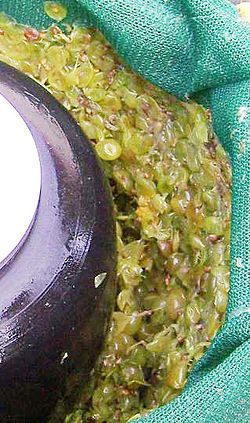Pomace
[2] The word was originally used for cider and only later applied to the apple mash before or after pressing, via various cognate terms in northern French dialects, before being used for such byproducts more generally.
The resulting liquid produced a thin, weak, and thirst-quenching wine with an alcohol content around 3 or 4%, now known as piquette in English and French and as graspia or vin piccolo in Italian.
The color of red wine is derived from skin contact during the maceration period, which sometimes includes partial fermentation.
[citation needed] In white wine production, grapes are separated from their skins, then pressed to obtain juice.
As envisioned, pomace would be introduced into anaerobic digesters that contain microorganisms that aid in its decomposition and produce methane gas that could be burnt to generate power.
A study conducted at the Eastman Dental Center found that these polyphenols interfere with Streptococcus mutans, the bacterium in the mouth that causes tooth decay.
Professor Hyun Koo, the lead researcher of the study, hoped as of 2008 to isolate these polyphenols to produce new mouthwashes that will help protect against cavities.
A 2004 study conducted by Erciyes University in Turkey found that pomace can also act as a natural food preservative that interferes with E. coli, Salmonella and Staphylococcus bacteria.
[11] Apple pomace was used, in conjunction with whey, to flavor the first iteration of Fanta soft drink in Germany during World War II.

